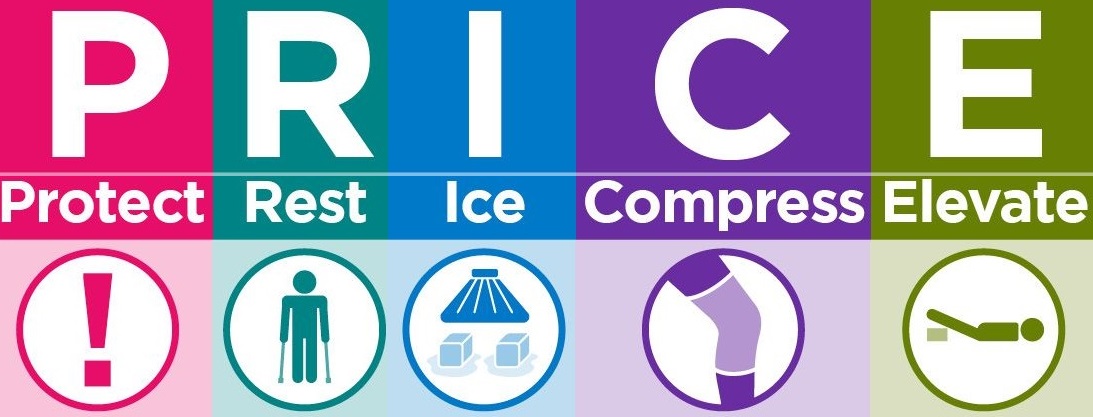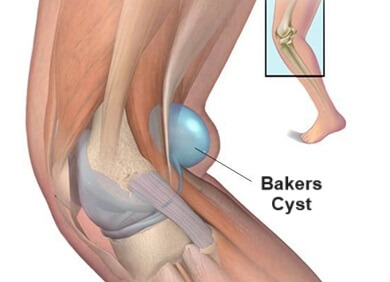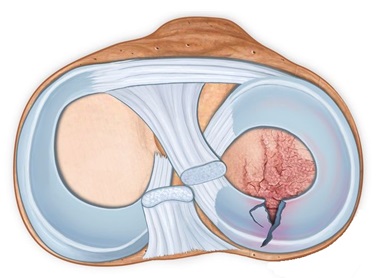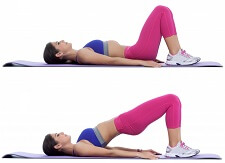- Home
- Knee Pain Diagnosis
- Pain Behind The Knee
Pain Behind the Knee (Posterior Pain)
Written By: Chloe Wilson, BSc(Hons) Physiotherapy
Reviewed by: KPE Medical Review Board

Pain behind the knee, aka posterior knee pain, is a common problem often accompanied by swelling.
It may develop suddenly following a knee injury or gradually from repetitive overuse or irritation.
Back of knee pain may affect your daily activities, walking, running, going up and down stairs and sports, but there are lots of things you can do to help. If the pain is slightly further up your leg, check out the upper thigh pain article.
What Causes Back Of Knee Pain?
There are a number of causes of pain behind the knee which all present slightly differently.
1. Baker's Cyst
The most common cause of swelling and pain behind the knee is a Baker's Cyst.
This is when fluid collects in the popliteal bursa located at the back of the knee causing it to swell. It often ends up feeling like there is a squashy orange behind the knee.
A Baker's Cyst may develop following an injury or from chronic inflammation at the knee, commonly associated with arthritis.
Find Out More: Baker's Cyst
2. Hamstring Injury
Hamstring injuries are another common cause of posterior knee pain, particularly if there is tightness or weakness in the muscles.
Hamstring Tendonitis: repetitive overuse causes inflammation and irritation of the hamstring tendons at the back of the knee. It most typically affects runners, cyclists and swimmers
Hamstring Tear: Sudden overloading or overstretching of the hamstrings can cause the fibers to tear. Hamstring tears usually occur during sudden fast movements such as sprinting, lunging and jumping
Find Out More: Hamstring Tendonitis and Pulled Hamstring
3. Meniscus Tear
The knee is lined with two rings of extra-thick cartilage, the meniscus, that work to cushion and absorb shock through the joint.
Pain behind the knee from a meniscus tear can develop suddenly from an injury, usually twisting awkwardly, or gradually from repetitive wear and tear. Meniscus tears often cause problems with squatting and going down stairs.
Find Out More: Meniscus Tears
4. Ligament Sprain
Knee ligament sprains can also cause posterior knee pain and are often associated with knee instability and giving way.
There are four ligaments located around the knee. Ligament sprains are usually caused by a large force through the knee e.g. awkward tackle or RTA, or sudden twisting movements e.g quickly pivoting when wearing cleats/studs.
Find Out More: Ligament Sprains
5. Knee Arthritis
The most common cause of pain behind the knee in people over 50 is knee arthritis.
With knee arthritis, there is gradual wear and tear of the knee cartilage and bones which can lead to swelling, grinding and stiffness in the knee, particularly after rest.
Find Out More: Knee Arthritis
6. Calf Tear
Sudden posterior knee pain that extends down into the back of the calf is often due to a tear in the calf muscle.
Sudden overloading or overstretching of the calf muscles, such as quickly changing speed or direction when running, can cause the muscle to tear, making it difficult to walk and push up through your tiptoes.
Find Out More: Pulled Calf Muscle
7. Hyperextended Knee
If the knee is suddenly forced backwards too far, it can damage the structures at the back of the knee resulting in posterior knee pain.
Knee hyperextension is a common sporting injury often associated with being tackled from in-front, landing awkwardly from a jump or skiing injuries.
Find Out More: Hyperextended Knee
8. DVT
A DVT is a blood clot that forms in the back of the leg. If you develop intense pain in the back of the knee or calf associated with redness, heat and swelling, you may have a DVT and should seek urgent medical assistance.
Symptoms Of Posterior Knee Pain
There are lots of different symptoms that may be experienced with pain behind the knee, depending on the underlying cause, including:
- Swelling: posterior knee pain is often accompanied by swelling. A distinct pocket of swelling is usually a Bakers Cyst whereas more generalized swelling is usually from a soft tissue injury
- Instability: pain behind the knee associated with knee instability or giving way is usually due to a ligament tear
- Popping Noise: if there was an audible "pop" at the time of injury, it usually indicates a ligament or meniscus tear
- Locking: if your knee locks, i.e. get stuck in one position, the may be a broken piece of cartilage stuck in the joint
- Restricted Movement: knee movement may be reduced either due to swelling or pain behind the knee making it harder to fully bend and straighten your leg
- Activity Limitations: activities such as walking, running, kneeling and going up and down stairs may be affected
Diagnosing Pain Behind The Knee
It is really important to know what is causing your posterior knee pain to make sure you get the right treatment. Your doctor will want to know about your symptoms and medical history including:
- when and how the pain started
- what makes the knee feel better or worse
- any associated symptoms such as instability of swelling
- your normal activity level
They will often be able to diagnose what is wrong from your history and a thorough physical examination, but they may want to send you for imaging studies such as x-rays, MRI or CT scan if they suspect something more serious.
Most cases of posterior knee pain will settle down within a few days but if not, or with more serious injuries, you should get checked out by your doctor.
When To See Your Regular Doctor
- moderate knee pain
- knee regularly clicks, gives way or locks
- constant knee pain
- you develop a fever
- symptoms are getting worse or haven't improved after 7 days
When To Seek Urgent Medical Attention
- severe knee pain, swelling or bruising
- obvious knee deformity
- you heard a cracking or popping noise at the time of injury
- you are unable to take any weight through the leg
- the knee is red, hot and swollen
- any change in your bladder or bowel control
- Loss of sensation in one or both feet
- Unexplained weight loss
Treatment For Posterior Knee Pain
The best place to start when treating pain behind the knee is with PRICE:
- Protect: the knee from further injury e.g. using crutches or a knee brace
- Rest: the knee from aggravating activities but usually not for too long. The knee can quickly become weak and tight if you rest too much which can cause more problems
- Ice: regularly applying ice packs for 10-15 minutes every couple of hours helps to reduce swelling and pain behind the knee, and speeds up healing
- Compression: wearing a tubigrip compression bandage helps to reduce knee swelling and support the joint
- Elevation: when resting, elevate your leg on cushions or pillows, ideally higher than your heart to reduce swelling

After a few days of PRICE treatment, you can start more specific treatment depending on what is causing your back of knee pain:
- Bakers Cyst Treatment
- Knee Sprain Treatment
- Meniscus Tear Treatment
- Calf Muscle Tear Treatment
- Knee Arthritis Treatment
- Hyperextended Knee Treatment
- Hamstring Tendonitis Treatment
- Hamstring Strain Treatment
FAQ's On Posterior Knee Pain
What is The Muscle in The Back of The Knee?
What is The Muscle in The Back of The Knee?
There are a few muscles in the back of the knee.
- Hamstrings: travel down the back of the thigh to the sides and back of the knee.
- Popliteus: a small muscle found in the back of the knee, stabilises and rotates the knee.
- Gastrocnemius: arises from the back of the knee forming part of the calf muscle.
Find out more about each of these in the knee muscles section and how injuries to them can cause back of knee pain.
How Do I Know If I Have a Blood Clot in My Leg?
How Do I Know If I Have a Blood Clot in My Leg?
With a blood clot in the leg, there is typically redness and warmth but only in one leg. Pulling your toes up towards you will make your pain worse.
The pain from a DVT can come on suddenly or gradually over time, caused by periods of inactivity, obesity, pregnancy or genetics. Seek medical attention immediately if you suspect a DVT is causing your back of knee pain.
What Are The Best Exercises for Treating Pain in the Back of Your Knee?
What Are The Best Exercises for Treating Pain in the Back of Your Knee?
Exercises are a great way for treating pain in the back of your knee.
They will typically involve strengthening the major muscles in the upper and lower leg to provide more support to the knee joint and stretches to improve flexibility:
- Quad Strengthening & Stretching: front of thigh muscles
- Hamstring Strengthening & Stretching: back of thigh muscles
- Glutes Strengthening & Stretching: buttock muscles
- Calf Strengthening & Stretching: back of calf muscles
For a whole range of knee exercise programs go to our knee exercises section.
Pain Behind The Knee Summary
The most common causes of pain behind the knee are a bakers cyst, meniscus tear, ligament sprain and hamstring injuries.
Pain behind the kneecap is usually caused by Runners Knee (problem with how the kneecap glides) or Chondromalacia Patella (thinning of the kneecap cartilage.
Tightness behind the knee is usually caused by hamstring injuries or posterior knee swelling
The most common cause of swelling behind the knee is Bakers Cyst where fluid collects at the back of the knee. Other possibilities include a calf tear, popliteal aneurysm or synovial sarcoma.
A sharp pain behind the knee, particularly after an injury is often caused by a meniscus tear. Sharp pain behind the knee in runners is often from a pulled hamstring or hamstring tendonitis, whereas in cyclists is often caused by a calf tear.
Posterior knee pain when bending the knee usually occurs when there is swelling in the knee, typically a bakers cyst.
The most common cause of pain behind the knee when straightening the leg is a meniscus tear, particularly if you've been siting down or squatting. A pulled hamstring can also cause pain and limit how far you can straighten the knee.
While in most cases pain in the back of the knee does not indicate a serious problem, any new incidence of posterior knee pain that is severe or doesn't settle within a few days should be reviewed by your doctor as soon as possible.
Treatment will depend on the underlying cause but may involve a combination of PRICE, exercises, a knee brace, medication and physical therapy.
You might also be interested in the following articles:
- Pain In Top Of Thigh
- Knee Pain & Popping
- Swollen Knee Treatment
- Front Knee Pain
- Side Knee Pain
- Pain Above Knee
- Pain Below Knee
- Calf Pain
- Burning Knee Pain
- Knee Range Of Motion
- Knee Pain On Stairs
Related Articles
Medical & Scientific References
- Posterior Knee Pain. by S. English & C. Perret. Journal of Current Reviews in Musculoskeletal Medicine, Oct 2010
- Pain Behind Knee? Injury vs. Disease-Related Causes from University Health News, March 2018
- Bakers Cyst - NHS UK June 2018
- Meniscus Tears - OrthoInfo. American Academy of Orthopedic Surgeons
Page Last Updated: April 15th, 2025
Next Review Due: April 15th, 2027







